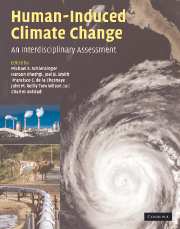Book contents
- Frontmatter
- Contents
- List of contributors
- Preface
- Part I Climate system science
- Part II Impacts and adaptation
- Part III Mitigation of greenhouse gases
- 15 Bottom-up modeling of energy and greenhouse gas emissions: approaches, results, and challenges to inclusion of end-use technologies
- 16 Technology in an integrated assessment model: the potential regional deployment of carbon capture and storage in the context of global CO2 stabilization
- 17 Hydrogen for light-duty vehicles: opportunities and barriers in the United States
- 18 The role of expectations in modeling costs of climate change policies
- 19 A sensitivity analysis of forest carbon sequestration
- 20 Insights from EMF-associated agricultural and forestry greenhouse gas mitigation studies
- 21 Global agricultural land-use data for integrated assessment modeling
- 22 Past, present, and future of non-CO2 gas mitigation analysis
- 23 How (and why) do climate policy costs differ among countries?
- 24 Lessons for mitigation from the foundations of monetary policy in the United States
- Part IV Policy design and decisionmaking under uncertainty
- Index
- Plate section
- References
23 - How (and why) do climate policy costs differ among countries?
from Part III - Mitigation of greenhouse gases
Published online by Cambridge University Press: 06 December 2010
- Frontmatter
- Contents
- List of contributors
- Preface
- Part I Climate system science
- Part II Impacts and adaptation
- Part III Mitigation of greenhouse gases
- 15 Bottom-up modeling of energy and greenhouse gas emissions: approaches, results, and challenges to inclusion of end-use technologies
- 16 Technology in an integrated assessment model: the potential regional deployment of carbon capture and storage in the context of global CO2 stabilization
- 17 Hydrogen for light-duty vehicles: opportunities and barriers in the United States
- 18 The role of expectations in modeling costs of climate change policies
- 19 A sensitivity analysis of forest carbon sequestration
- 20 Insights from EMF-associated agricultural and forestry greenhouse gas mitigation studies
- 21 Global agricultural land-use data for integrated assessment modeling
- 22 Past, present, and future of non-CO2 gas mitigation analysis
- 23 How (and why) do climate policy costs differ among countries?
- 24 Lessons for mitigation from the foundations of monetary policy in the United States
- Part IV Policy design and decisionmaking under uncertainty
- Index
- Plate section
- References
Summary
Introduction
There have been many studies of the cost to Annex B countries of meeting Kyoto Protocol commitments. Unfortunately for these analyses, the Protocol has proved to be a moving target in terms of its interpretation and likely implementation. In addition, the economic performance and future expectations for some parties also are changing, and with these changes come revisions in reference emissions, which have a strong influence on the projected cost of meeting Protocol requirements. Looking back across these studies, the progression of work can be divided into three broad phases. The first studies were conducted soon after the Protocol was signed in 1997, and they focused on carbon emissions from fossil fuels. Often they assumed an idealized system of harmonized carbon taxes, or cap-and-trade among all the Annex B parties, contrasting such systems with implementation without international permit trade but with an idealized trading system operating within each country (see, for example, Weyant and Hill [1999]). These studies showed a high cost of the Protocol with autarkic compliance, but huge benefits of international trading because it made Russian “hot air” (potentially tradable emission quotas in excess of their anticipated emissions) accessible to other Annex B parties.
A second phase of studies followed the final negotiations in Marrakech in 2001 (Manne and Richels, 2001; Babiker et al., 2002; Bohringer, 2002). By that time, the United States had withdrawn from the Protocol, and the potential contribution of Article 3.4 carbon sinks had been defined for each party.
- Type
- Chapter
- Information
- Human-Induced Climate ChangeAn Interdisciplinary Assessment, pp. 282 - 293Publisher: Cambridge University PressPrint publication year: 2007
References
- 7
- Cited by

